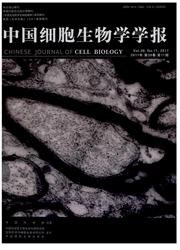

 中文摘要:
中文摘要:
利用具Pm21的小麦–簇毛麦染色体易位系6AL/6VS为抗病供体,与对白粉病敏感的优良小麦栽培品种京411为轮回亲本杂交、F1个体回交7次,培育了近等基因系(near-isogenic line,NIL)。利用蛋白质组技术,检测了NIL的选择效率,叶子蛋白质组分析发现,NIL中有43.8%的蛋白质组斑点变化倾向于抗病供体亲本6AL/6VS,56.2%的蛋白质组斑点变化倾向于轮回亲本京411。胚根中有41.7%的蛋白质组斑点变化倾向于抗病亲本6AL/6VS,58.3%的蛋白质组斑点变化倾向于轮回亲本京411。通过MS/MS分析,在NIL中有23个蛋白质斑点产生表达变化,它们是:ATP synthase beta subunit、glycosyltransferase family 2 protein、Rab7/RabG-family small GTPase、COP1-interacting protein 7、cryptochrome 1a、ribosomal protein L16、transcription initiation factor TFIID subunit、23.5 kDa heat-shock protein、POR、RIC1、NBS-LRR resistance protein、transcription factor、serine/threonine-protein kinase haspin、F-actin capping protein beta subunit、mitochondrial protein translocase family、maturase K、NADH dehydrogenase subunit F、chloroplast Tha 4-2、mitochondrial translational initiation factor、ATP binding protein、SNF-1 related kinase、heat shock protein 70和lipase family protein。这些蛋白质斑点的功能涉及能量代谢、糖代谢、信号传导、光合反应、DNA和蛋白质合成以及环境胁迫。蛋白质组检测所得结果能反映出NIL的培育与选择效果。
 英文摘要:
英文摘要:
In this study, we cultured a near-isogenic line (NIL) of Jing 411 and we are also evaluation the selection effects of near-isogenic line by proteomic techniques. Jing 411, which is a fine wheat variety but susceptible to powdery mildew pathogen, was crossed with wheat (H. villosurn) chromosome translocation line 6AL/6VS. The donor of the resistance gene, F1 individuals then were back-crossed with Jing 411 seven times and selfed to produce progenice (NIL). The proteome of leaves and roots were investigated and the results indicated that 43.8% protein spots changed had a tendency to 6AL/6VS and 56.2% had a tendency to recurrent parent Jing 411 in leaves of NILS. In roots, 41.7% protein spots changed had a tendency to 6AL/6VS and 58.3% protein spots changed tended to recurrent parent Jing 411.23 protein spots were identified by MS/MS. They were ATP synthase beta subunit, glycosyltransferase family 2 protein, Rab7/RabG-family small GTPase, COP 1-Interacting protein 7, cryptochrome 1a, ribosomal protein L 16, transcription initiation factor TFIID subunit, 23.5 kDa heat-shock protein, POR, RIC 1, NBS-LRR resistance protein, transcription factor, serine/threonine-protein kinase haspin, F-actin capping protein beta subunit, mitochondrial protein translocase family, maturase K, NADH dehydrogenase subunit F, chloroplast Tha 4-2, mitochondrial translational initiation factor, ATP binding protein, SNF-1 related kinase, heat shock protein 70 and lipase family protein. The identified proteins were found to de involved in diverse biological processes, covering energy pathway, glucose-metabolism, signal transduction, photoreaction, DNA and RNA synthesis and defense response. Proteome technique can be used to evaluation the selection effect of NIL.
 同期刊论文项目
同期刊论文项目
 同项目期刊论文
同项目期刊论文
 期刊信息
期刊信息
